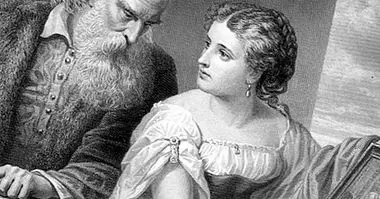Linguistic resources: characteristics, examples and types
Linguistic resources are some of the components that make up a discourse. It is about the procedures and elements that we use in specific ways to communicate. As such, linguistic resources exist in both written discourses and oral discourses.
In this text We will see in more detail what linguistic resources are , as well as some types and examples of these.
- Related article: "The 12 types of language (and their characteristics)"
What are the linguistic resources?
The language can be defined as the communication system that we use to exchange different types of information . As a system, it is characterized by a set of elements that are intertwined and that have particular uses.
In turn, these uses vary according to the context in which they are presented and in accordance with the communicative purpose: each element can be used in one way or another according to the purpose of the message that it wants to transmit.
Put another way, for a speech to communicate something, it is necessary to make use of the codes offered by the communicative context . This use occurs through procedures or means at our disposal to satisfy the need to communicate.
In fact, this last is what we understand by the word "resource". Thus, we see that a "linguistic resource" is a procedure or means that we have to satisfy the need to communicate something. These resources are also known as "literary resources" or "literary figures." The nomination varies according to the gender of the speech and specific use of the resource .
In addition, language is not only a means of expression and reflection of our ideas. It is also an element that intervenes and conditions the constitution of a social reality (Santander, 2011, cited by Rubio, 2016).
This means that, beyond helping us to transmit and exchange information, linguistic resources can give us important guidelines to understand a social reality. For the same reason they are elements frequently studied in discourse analysis in different contexts.
In the same sense, according to the genre and the objectives of the text, linguistic resources can go hand in hand with strategies that they help fulfill a certain communicative purpose . Examples of these strategies are persuasion, generalization, evaluation, naturalization, authorization, among others. Finally, linguistic resources are also considered as material supports that allow us to access discourses.
- Maybe you're interested: "The 13 types of text and their characteristics"
Types and examples
Now, what elements do we use to give legibility or coherence to a discourse, be it oral or written? Next we will see some types and examples of linguistic resources applied to the speech, as well as some examples according to the support that contains them.
1. Phonetic resources
It's about elements that help us highlight a specific part of the message through its sounds . Hence, they are known as "phonetic" resources. Among the most common subtypes are the following:
- Alliteration : production of sound effects by the repetition of one or several phonemes, p. ex. "The noise with which the rock rolls" or "three sad tigers swallowed wheat".
- Onomatopoeia : imitate natural noises to convey a message or idea, and that can become words, p. ex. "Meow" and "meow".
- Paronomasia : similarity of sounds between words that are almost the same but different, for example "horse" and "hair".
- Palindromia or palindrome : words that are read equally from left to right and from right to left, p. ex. "Anita washes the tub".
2. Semantic resources or rhetorical elements
They are the elements that give an account of the relationship between the meaning and the signifier, that is, that allow to establish a specific meaning to each concept. Among the most representative are:
- Comparison : relate an idea or word with another that is clearer, more expressive or more concrete and whose meaning is similar to the one we are introducing.
- Metaphor : identify a word or phrase with another that is different but that shares meaning, p. ex. "The windows of the soul" to refer to the eyes. The difference with the comparison is that in the case of the metaphor it does not make explicit the relationship between the two ideas.
- Metonymy : it is about naming something with a different concept but that is related.For example, "take a bottle of ..." (replacing the liquid with the container).
- Allegory : is the sequenced use of metaphors within a literary text
- Antithesis : contrast one phrase with another that has an opposite meaning, p. ex. "Child of legal age".
- Hyperbole : exaggerating or minimizing qualities or actions, for example of the characters in a text.
- Prosopopoeia : is to attribute human properties to inanimate beings.
3. Morphological resources
The morphological resources are those that allow to make use of the composition of the words, their forms and their internal structures. Some examples of this are the following:
Epithet : use qualifying adjectives to highlight natural qualities, even if they do not add extra information, p. ex. "the White snow". Enumeration : use a series of nouns whose meaning is similar to describe or highlight a meaning.
4. Syntactic resources or cohesive elements
Syntactic resources are those that refer to the specific order of each word within a sentence, so that it is possible to highlight ideas. Likewise they allow to organize the speeches in a determined way, generating a logical order of these ideas. Some of the most common are:
- Anaphora : repeat the same word at the beginning of each sentence or verse
- Hyperbaton : modify the grammatical order of the words so that an idea is highlighted, p. ex. "Of green willows there is thickets".
- Connectors : those grammatical elements that indicate hierarchy, opposition, relationship or temporality, p. ex. "At the beginning", "nonetheless", "in sum", "below".
- Reference : indicates the relationship between the elements of the text mentioned above, or establishes a relationship between a newly proposed idea and the specification of the elements to which it refers.
- Asyndeton : intentionally suppress conjunctions or links to join several words, for example replace them with commas: "go, run, fly"
- Polysyndeton : contrary to the previous one, it consists of superimposing several conjunctions, for example using the "and" repeatedly: "and run, and jump, and grow, and throw".
- Adverbs : they serve to modify, specify or exalt the meaning of a verb, an adjective or another adverb, eg "live far away", "it is extraordinarily active", "it is very unpleasant".
5. Resources according to the support
On the other hand, depending on the support, they can also be examples of linguistic resources all those devices that allow us to access certain information . That is, the files and tools for consultation or access to any information element. Examples of this are dictionaries, encyclopedias, translators, applications or online consultation platforms, and so on.
Bibliographic references:
- Literary resources (2018). Definition of. Retrieved September 25, 2018. Available in //definicion.de/recursos-literarios/.
- Linguistic resources (2018). Elhuyar Retrieved September 25, 2018. Available at //www.elhuyar.eus/es/site/servicios/teknologias/recursos-linguisticos.
- Rubio, T. (2016). Analysis of the linguistic resources used by the reader's advocates for the confidence of press users. Journal of Linguistic Research, 19: 295-322.
- Salas, C. (2011). The cohesive elements in written academic discourse: an experience from the university context. Legenda, 15 (13): 29-55.
- TsEdi (2018). Classes of literary resources. Retrieved September 25, 2018. Available at //blog.tsedi.com/clases-de-recursos-literarios/.



















